MGTP102 - Employee Motivation: Monetary vs. Non-Monetary Benefits
VerifiedAdded on 2023/04/03
|8
|1906
|434
Essay
AI Summary
This essay explores the importance of motivation in the workplace, examining whether monetary incentives are the sole driver or if non-financial factors play a significant role. It analyzes the arguments for and against financial motivation, referencing Maslow's hierarchy of needs and Herzberg's two-factor theory. The essay concludes that both financial and non-financial incentives are crucial for employee motivation, recommending a balanced approach that includes fair pay, a positive work environment, and opportunities for growth and recognition. The essay emphasizes that a holistic approach to employee motivation is essential for achieving organizational success.
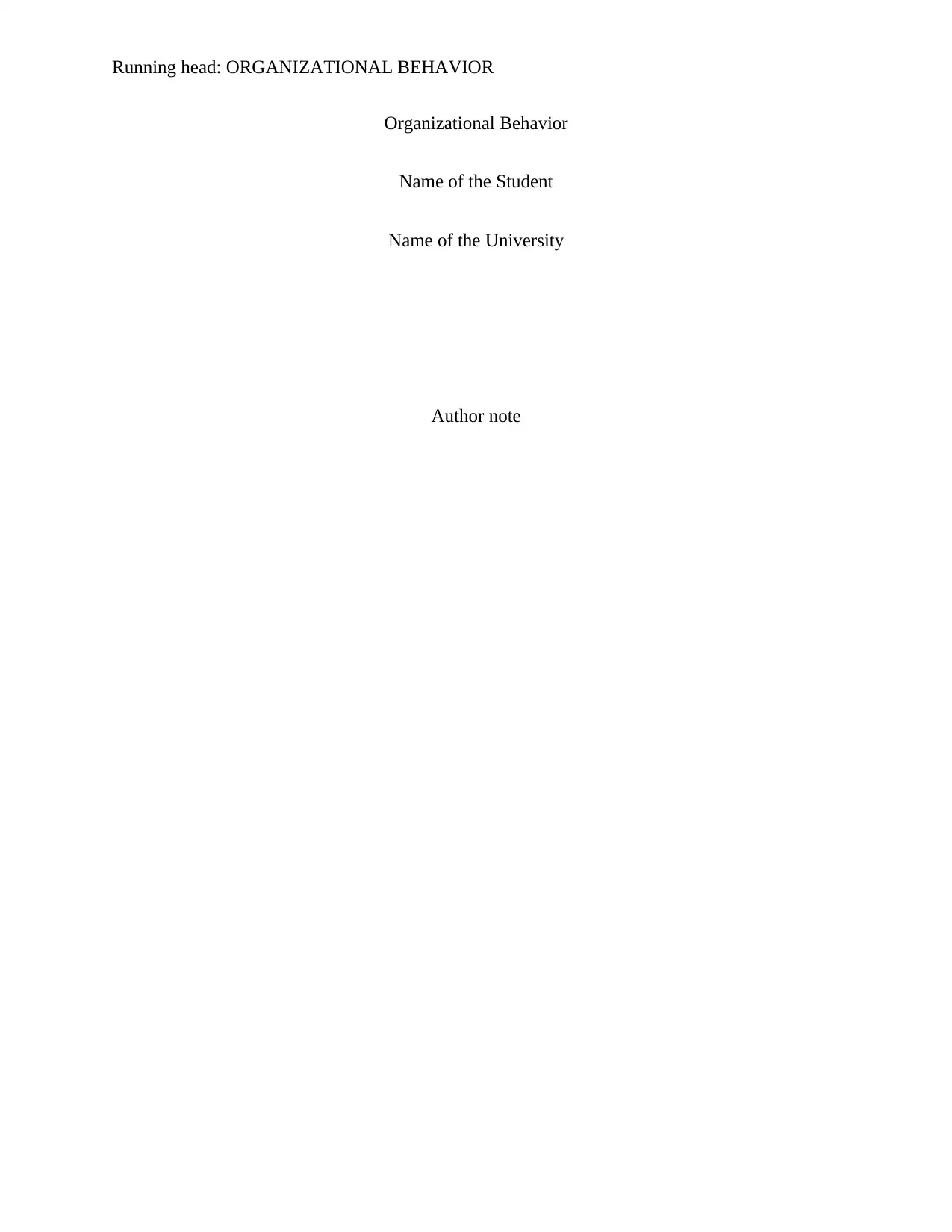
Running head: ORGANIZATIONAL BEHAVIOR
Organizational Behavior
Name of the Student
Name of the University
Author note
Organizational Behavior
Name of the Student
Name of the University
Author note
Paraphrase This Document
Need a fresh take? Get an instant paraphrase of this document with our AI Paraphraser
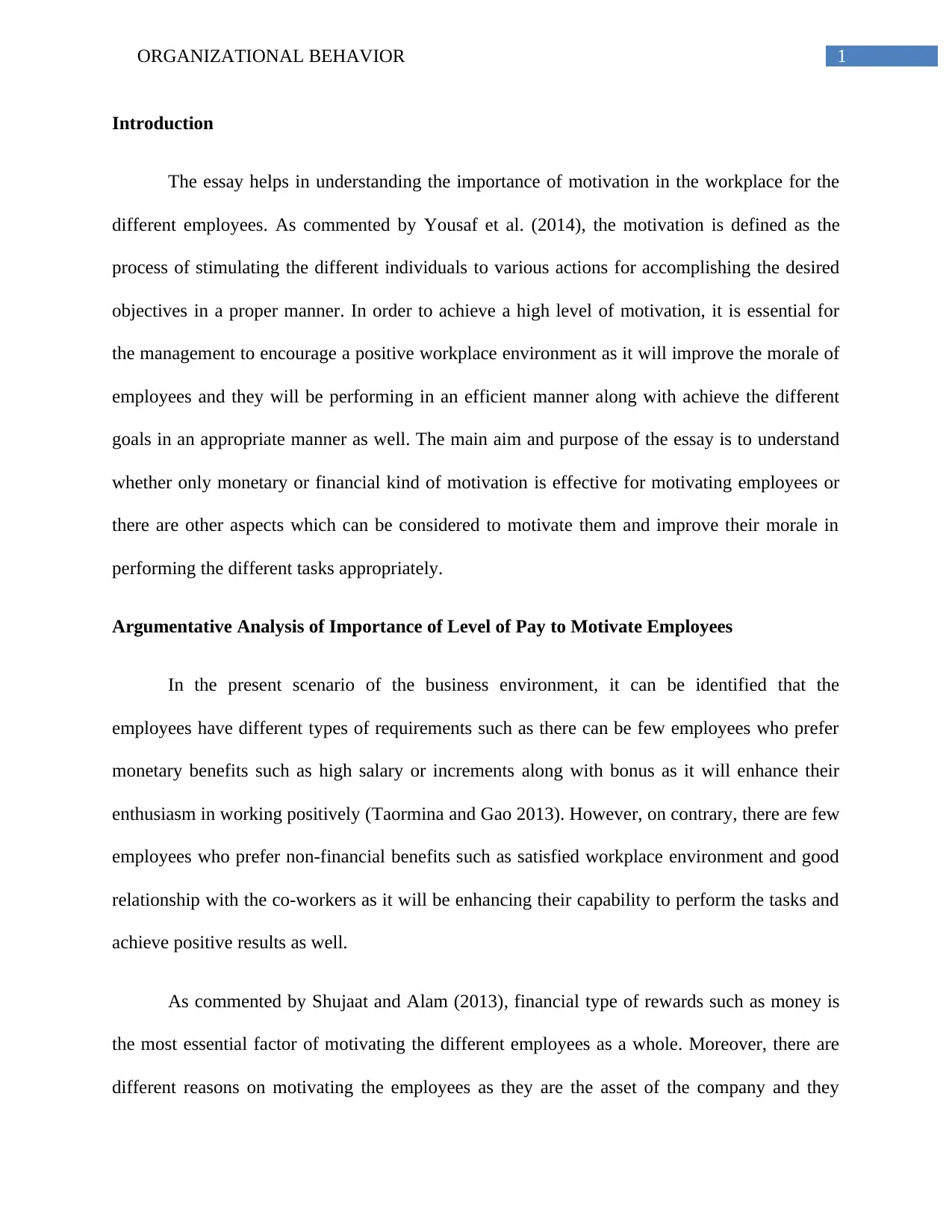
1ORGANIZATIONAL BEHAVIOR
Introduction
The essay helps in understanding the importance of motivation in the workplace for the
different employees. As commented by Yousaf et al. (2014), the motivation is defined as the
process of stimulating the different individuals to various actions for accomplishing the desired
objectives in a proper manner. In order to achieve a high level of motivation, it is essential for
the management to encourage a positive workplace environment as it will improve the morale of
employees and they will be performing in an efficient manner along with achieve the different
goals in an appropriate manner as well. The main aim and purpose of the essay is to understand
whether only monetary or financial kind of motivation is effective for motivating employees or
there are other aspects which can be considered to motivate them and improve their morale in
performing the different tasks appropriately.
Argumentative Analysis of Importance of Level of Pay to Motivate Employees
In the present scenario of the business environment, it can be identified that the
employees have different types of requirements such as there can be few employees who prefer
monetary benefits such as high salary or increments along with bonus as it will enhance their
enthusiasm in working positively (Taormina and Gao 2013). However, on contrary, there are few
employees who prefer non-financial benefits such as satisfied workplace environment and good
relationship with the co-workers as it will be enhancing their capability to perform the tasks and
achieve positive results as well.
As commented by Shujaat and Alam (2013), financial type of rewards such as money is
the most essential factor of motivating the different employees as a whole. Moreover, there are
different reasons on motivating the employees as they are the asset of the company and they
Introduction
The essay helps in understanding the importance of motivation in the workplace for the
different employees. As commented by Yousaf et al. (2014), the motivation is defined as the
process of stimulating the different individuals to various actions for accomplishing the desired
objectives in a proper manner. In order to achieve a high level of motivation, it is essential for
the management to encourage a positive workplace environment as it will improve the morale of
employees and they will be performing in an efficient manner along with achieve the different
goals in an appropriate manner as well. The main aim and purpose of the essay is to understand
whether only monetary or financial kind of motivation is effective for motivating employees or
there are other aspects which can be considered to motivate them and improve their morale in
performing the different tasks appropriately.
Argumentative Analysis of Importance of Level of Pay to Motivate Employees
In the present scenario of the business environment, it can be identified that the
employees have different types of requirements such as there can be few employees who prefer
monetary benefits such as high salary or increments along with bonus as it will enhance their
enthusiasm in working positively (Taormina and Gao 2013). However, on contrary, there are few
employees who prefer non-financial benefits such as satisfied workplace environment and good
relationship with the co-workers as it will be enhancing their capability to perform the tasks and
achieve positive results as well.
As commented by Shujaat and Alam (2013), financial type of rewards such as money is
the most essential factor of motivating the different employees as a whole. Moreover, there are
different reasons on motivating the employees as they are the asset of the company and they

2ORGANIZATIONAL BEHAVIOR
should be enthusiastic in performing the different tasks and achieve productive results for the
organization. According to Ozguner and Ozguner (2014), the money plays a crucial role in
motivating individuals and therefore the management of organizations make use of the different
financial incentives such as salaries, bonuses or retirement benefits to motivate the employees
and help them in achieving the goals successfully. However, as hypothesized by Lau and
Roopnarain (2014), it can be identified that the incentives may not be motivating always,
therefore the companies need to introduce and increase the financial incentives level to keep the
employees with the organization. The same can be appreciated through making salaries or wages
competitive in nature in comparison to the other enterprises which will be helpful for attracting
as well as maintaining excellent workforce.
On the contrary, as stated by Kuznetsov et al. (2017), the monetary incentives can be
forming an important aspect in life of the employees; however, there are few aspects in life
which cannot be bought. The author stated that the main objectives of motivating the employees
are to provide them with best of the abilities as it will encourage them in performing well. In
such scenario, as commented by Jerome (2013), there can be inclusion of flexible working hours,
health savings, premium contributions along with paid sabbaticals which are equally essential
and it will be playing a major role in making them feel more motivated and these are termed as
non-monetary incentives.
However, on the contrary, Hotchkiss, Banteyerga and Tharaney (2015), have opined that
financial aspects are the most appropriate part of the life of the employees as it is helpful for
satisfying the physical needs of the individuals such as food, shelter and clothing. As commented
by Maslow, the money is the most appropriate aspects which should be maintained and provided
to the different employees as to satisfy their needs and Maslow has created hierarchy of needs in
should be enthusiastic in performing the different tasks and achieve productive results for the
organization. According to Ozguner and Ozguner (2014), the money plays a crucial role in
motivating individuals and therefore the management of organizations make use of the different
financial incentives such as salaries, bonuses or retirement benefits to motivate the employees
and help them in achieving the goals successfully. However, as hypothesized by Lau and
Roopnarain (2014), it can be identified that the incentives may not be motivating always,
therefore the companies need to introduce and increase the financial incentives level to keep the
employees with the organization. The same can be appreciated through making salaries or wages
competitive in nature in comparison to the other enterprises which will be helpful for attracting
as well as maintaining excellent workforce.
On the contrary, as stated by Kuznetsov et al. (2017), the monetary incentives can be
forming an important aspect in life of the employees; however, there are few aspects in life
which cannot be bought. The author stated that the main objectives of motivating the employees
are to provide them with best of the abilities as it will encourage them in performing well. In
such scenario, as commented by Jerome (2013), there can be inclusion of flexible working hours,
health savings, premium contributions along with paid sabbaticals which are equally essential
and it will be playing a major role in making them feel more motivated and these are termed as
non-monetary incentives.
However, on the contrary, Hotchkiss, Banteyerga and Tharaney (2015), have opined that
financial aspects are the most appropriate part of the life of the employees as it is helpful for
satisfying the physical needs of the individuals such as food, shelter and clothing. As commented
by Maslow, the money is the most appropriate aspects which should be maintained and provided
to the different employees as to satisfy their needs and Maslow has created hierarchy of needs in
⊘ This is a preview!⊘
Do you want full access?
Subscribe today to unlock all pages.

Trusted by 1+ million students worldwide

3ORGANIZATIONAL BEHAVIOR
which the money is considered to be the most significant aspects in the lives of individuals and it
is significant type of motivator to satisfy the three level of needs of employees working in the
organization. Moreover, as opined by Ghazi, Shahzada and Khan (2013), the managers in the
organizations tend to place more reliance on pay, monetary incentives and bonuses as these are
considered to be the elements as they are easiest in nature to manipulate.
Maslow has commented that the main focus of the companies should be on pay which is
being provided by them to the different employees working in the organization. The basic needs
such as food and shelter can be achieved with money and it is the most crucial element that
should be awarded to employees to improve their morale and make them satisfied with the same
to help the company in achieving organizational objectives. Additionally, as opined by
Dellaportas (2013), the bonus is considered to be the most effective aspects which should be
managed by the company as it acts as the incentive to perform better and increase the overall
productivity of the company as a whole.
On the contrary, Herzberg has hypothesized that pay has only little to do with motivating
the different employees in an efficient manner. Herzberg strongly condemns that the monetary
incentives along with hygiene factors play a vital role in improving the morale of employees and
increase their job satisfaction. Moreover, as opined by Ameh and Shokumbi (2013), the
employees need non-financial motivation is due to the major four reasons which includes that
they feel that financial incentives may not be fair and it will demotivate the employees for their
future endeavors. In addition, Alshmemri, Shahwan-Akl and Maude (2017), have opined that the
financial scheme related to incentives are difficult in nature to operate and it generates unfair
treatment for the employees as to perform in a positive manner and gain productivity for the
organization as well.
which the money is considered to be the most significant aspects in the lives of individuals and it
is significant type of motivator to satisfy the three level of needs of employees working in the
organization. Moreover, as opined by Ghazi, Shahzada and Khan (2013), the managers in the
organizations tend to place more reliance on pay, monetary incentives and bonuses as these are
considered to be the elements as they are easiest in nature to manipulate.
Maslow has commented that the main focus of the companies should be on pay which is
being provided by them to the different employees working in the organization. The basic needs
such as food and shelter can be achieved with money and it is the most crucial element that
should be awarded to employees to improve their morale and make them satisfied with the same
to help the company in achieving organizational objectives. Additionally, as opined by
Dellaportas (2013), the bonus is considered to be the most effective aspects which should be
managed by the company as it acts as the incentive to perform better and increase the overall
productivity of the company as a whole.
On the contrary, Herzberg has hypothesized that pay has only little to do with motivating
the different employees in an efficient manner. Herzberg strongly condemns that the monetary
incentives along with hygiene factors play a vital role in improving the morale of employees and
increase their job satisfaction. Moreover, as opined by Ameh and Shokumbi (2013), the
employees need non-financial motivation is due to the major four reasons which includes that
they feel that financial incentives may not be fair and it will demotivate the employees for their
future endeavors. In addition, Alshmemri, Shahwan-Akl and Maude (2017), have opined that the
financial scheme related to incentives are difficult in nature to operate and it generates unfair
treatment for the employees as to perform in a positive manner and gain productivity for the
organization as well.
Paraphrase This Document
Need a fresh take? Get an instant paraphrase of this document with our AI Paraphraser
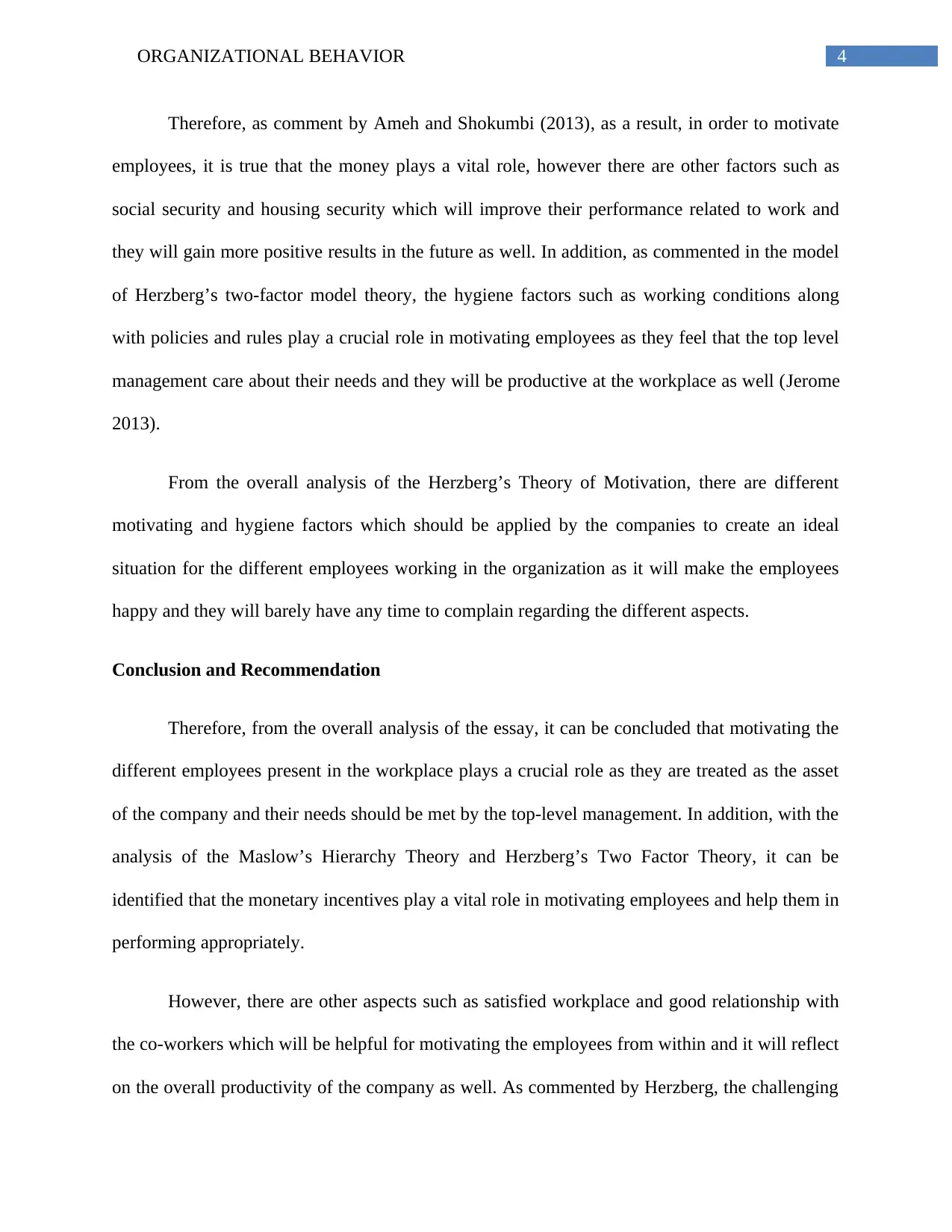
4ORGANIZATIONAL BEHAVIOR
Therefore, as comment by Ameh and Shokumbi (2013), as a result, in order to motivate
employees, it is true that the money plays a vital role, however there are other factors such as
social security and housing security which will improve their performance related to work and
they will gain more positive results in the future as well. In addition, as commented in the model
of Herzberg’s two-factor model theory, the hygiene factors such as working conditions along
with policies and rules play a crucial role in motivating employees as they feel that the top level
management care about their needs and they will be productive at the workplace as well (Jerome
2013).
From the overall analysis of the Herzberg’s Theory of Motivation, there are different
motivating and hygiene factors which should be applied by the companies to create an ideal
situation for the different employees working in the organization as it will make the employees
happy and they will barely have any time to complain regarding the different aspects.
Conclusion and Recommendation
Therefore, from the overall analysis of the essay, it can be concluded that motivating the
different employees present in the workplace plays a crucial role as they are treated as the asset
of the company and their needs should be met by the top-level management. In addition, with the
analysis of the Maslow’s Hierarchy Theory and Herzberg’s Two Factor Theory, it can be
identified that the monetary incentives play a vital role in motivating employees and help them in
performing appropriately.
However, there are other aspects such as satisfied workplace and good relationship with
the co-workers which will be helpful for motivating the employees from within and it will reflect
on the overall productivity of the company as well. As commented by Herzberg, the challenging
Therefore, as comment by Ameh and Shokumbi (2013), as a result, in order to motivate
employees, it is true that the money plays a vital role, however there are other factors such as
social security and housing security which will improve their performance related to work and
they will gain more positive results in the future as well. In addition, as commented in the model
of Herzberg’s two-factor model theory, the hygiene factors such as working conditions along
with policies and rules play a crucial role in motivating employees as they feel that the top level
management care about their needs and they will be productive at the workplace as well (Jerome
2013).
From the overall analysis of the Herzberg’s Theory of Motivation, there are different
motivating and hygiene factors which should be applied by the companies to create an ideal
situation for the different employees working in the organization as it will make the employees
happy and they will barely have any time to complain regarding the different aspects.
Conclusion and Recommendation
Therefore, from the overall analysis of the essay, it can be concluded that motivating the
different employees present in the workplace plays a crucial role as they are treated as the asset
of the company and their needs should be met by the top-level management. In addition, with the
analysis of the Maslow’s Hierarchy Theory and Herzberg’s Two Factor Theory, it can be
identified that the monetary incentives play a vital role in motivating employees and help them in
performing appropriately.
However, there are other aspects such as satisfied workplace and good relationship with
the co-workers which will be helpful for motivating the employees from within and it will reflect
on the overall productivity of the company as well. As commented by Herzberg, the challenging
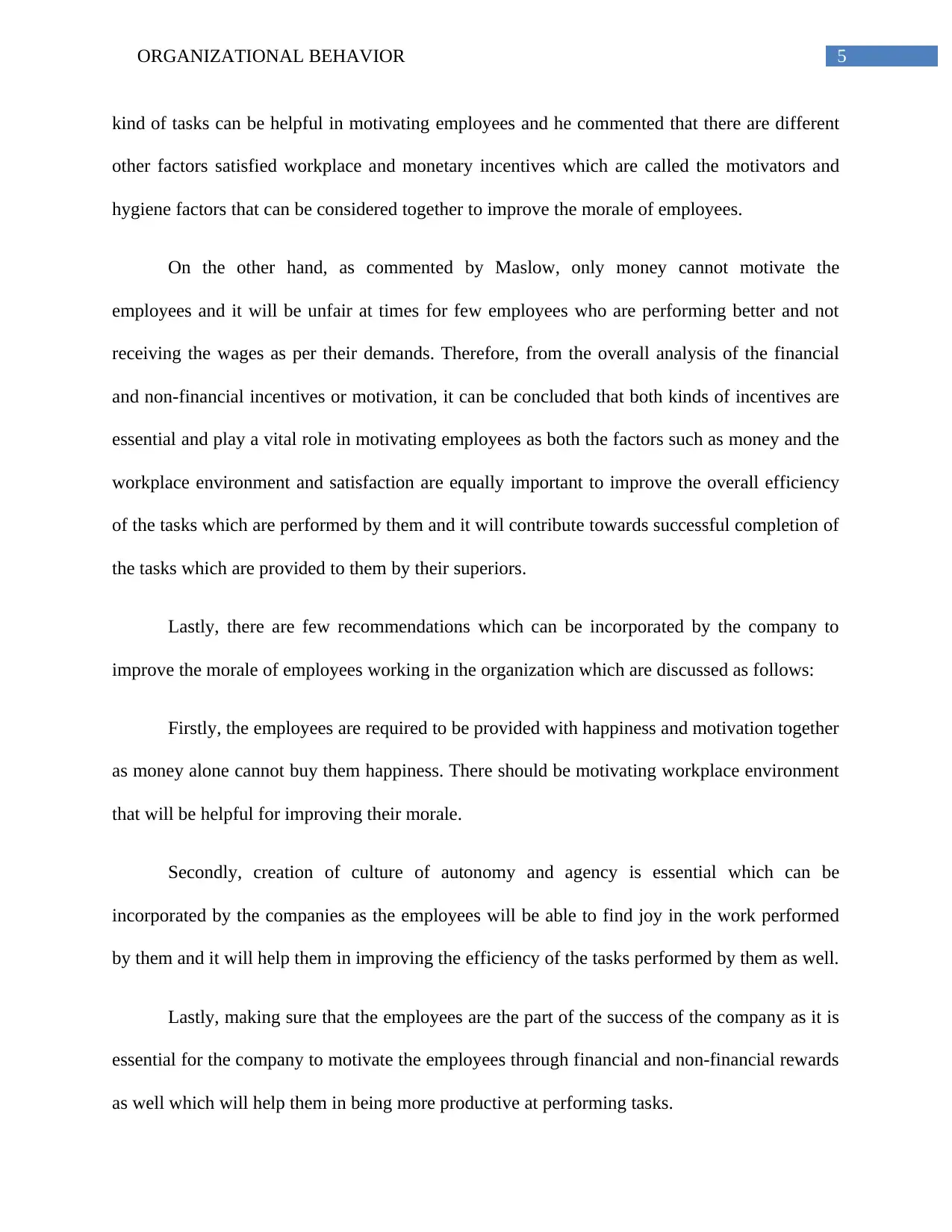
5ORGANIZATIONAL BEHAVIOR
kind of tasks can be helpful in motivating employees and he commented that there are different
other factors satisfied workplace and monetary incentives which are called the motivators and
hygiene factors that can be considered together to improve the morale of employees.
On the other hand, as commented by Maslow, only money cannot motivate the
employees and it will be unfair at times for few employees who are performing better and not
receiving the wages as per their demands. Therefore, from the overall analysis of the financial
and non-financial incentives or motivation, it can be concluded that both kinds of incentives are
essential and play a vital role in motivating employees as both the factors such as money and the
workplace environment and satisfaction are equally important to improve the overall efficiency
of the tasks which are performed by them and it will contribute towards successful completion of
the tasks which are provided to them by their superiors.
Lastly, there are few recommendations which can be incorporated by the company to
improve the morale of employees working in the organization which are discussed as follows:
Firstly, the employees are required to be provided with happiness and motivation together
as money alone cannot buy them happiness. There should be motivating workplace environment
that will be helpful for improving their morale.
Secondly, creation of culture of autonomy and agency is essential which can be
incorporated by the companies as the employees will be able to find joy in the work performed
by them and it will help them in improving the efficiency of the tasks performed by them as well.
Lastly, making sure that the employees are the part of the success of the company as it is
essential for the company to motivate the employees through financial and non-financial rewards
as well which will help them in being more productive at performing tasks.
kind of tasks can be helpful in motivating employees and he commented that there are different
other factors satisfied workplace and monetary incentives which are called the motivators and
hygiene factors that can be considered together to improve the morale of employees.
On the other hand, as commented by Maslow, only money cannot motivate the
employees and it will be unfair at times for few employees who are performing better and not
receiving the wages as per their demands. Therefore, from the overall analysis of the financial
and non-financial incentives or motivation, it can be concluded that both kinds of incentives are
essential and play a vital role in motivating employees as both the factors such as money and the
workplace environment and satisfaction are equally important to improve the overall efficiency
of the tasks which are performed by them and it will contribute towards successful completion of
the tasks which are provided to them by their superiors.
Lastly, there are few recommendations which can be incorporated by the company to
improve the morale of employees working in the organization which are discussed as follows:
Firstly, the employees are required to be provided with happiness and motivation together
as money alone cannot buy them happiness. There should be motivating workplace environment
that will be helpful for improving their morale.
Secondly, creation of culture of autonomy and agency is essential which can be
incorporated by the companies as the employees will be able to find joy in the work performed
by them and it will help them in improving the efficiency of the tasks performed by them as well.
Lastly, making sure that the employees are the part of the success of the company as it is
essential for the company to motivate the employees through financial and non-financial rewards
as well which will help them in being more productive at performing tasks.
⊘ This is a preview!⊘
Do you want full access?
Subscribe today to unlock all pages.

Trusted by 1+ million students worldwide
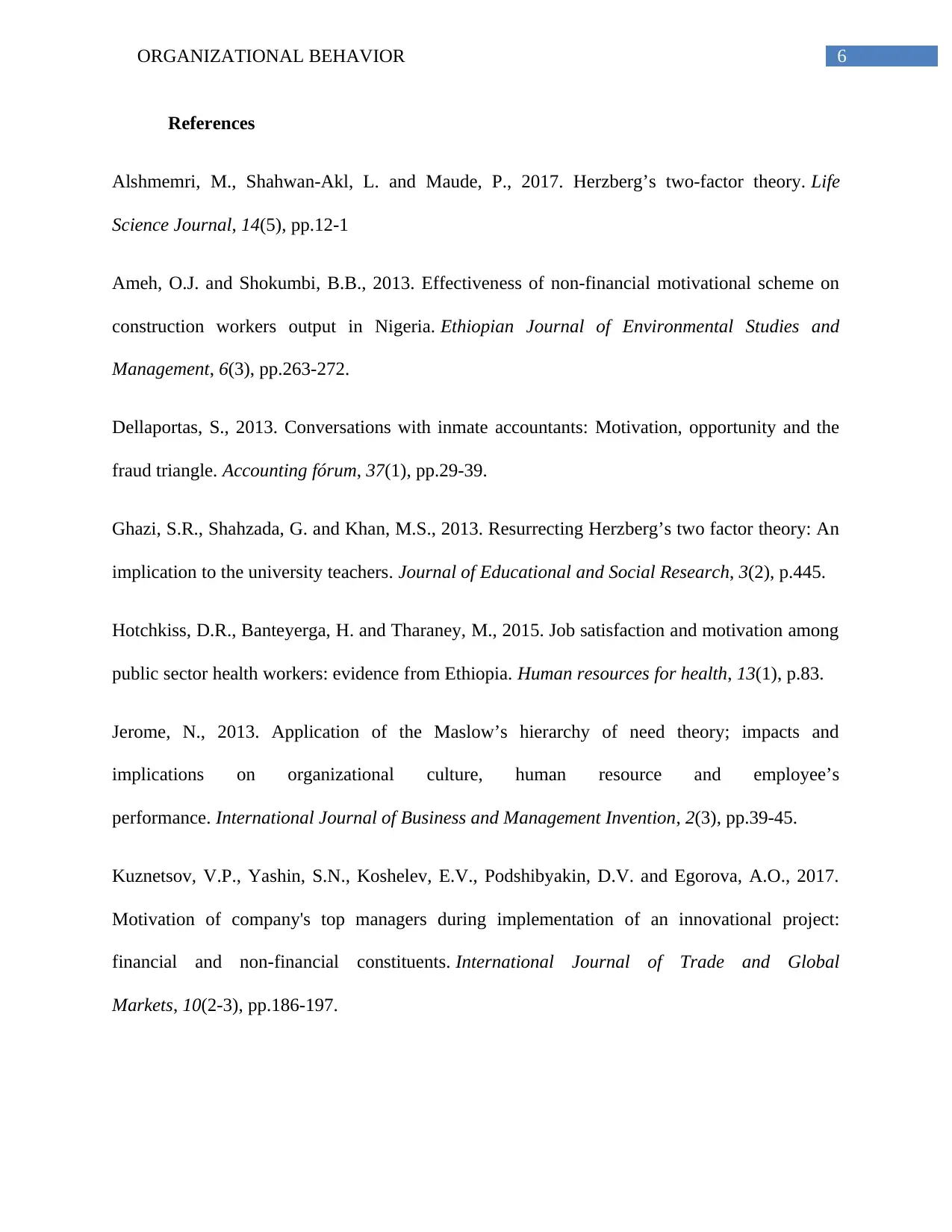
6ORGANIZATIONAL BEHAVIOR
References
Alshmemri, M., Shahwan-Akl, L. and Maude, P., 2017. Herzberg’s two-factor theory. Life
Science Journal, 14(5), pp.12-1
Ameh, O.J. and Shokumbi, B.B., 2013. Effectiveness of non-financial motivational scheme on
construction workers output in Nigeria. Ethiopian Journal of Environmental Studies and
Management, 6(3), pp.263-272.
Dellaportas, S., 2013. Conversations with inmate accountants: Motivation, opportunity and the
fraud triangle. Accounting fórum, 37(1), pp.29-39.
Ghazi, S.R., Shahzada, G. and Khan, M.S., 2013. Resurrecting Herzberg’s two factor theory: An
implication to the university teachers. Journal of Educational and Social Research, 3(2), p.445.
Hotchkiss, D.R., Banteyerga, H. and Tharaney, M., 2015. Job satisfaction and motivation among
public sector health workers: evidence from Ethiopia. Human resources for health, 13(1), p.83.
Jerome, N., 2013. Application of the Maslow’s hierarchy of need theory; impacts and
implications on organizational culture, human resource and employee’s
performance. International Journal of Business and Management Invention, 2(3), pp.39-45.
Kuznetsov, V.P., Yashin, S.N., Koshelev, E.V., Podshibyakin, D.V. and Egorova, A.O., 2017.
Motivation of company's top managers during implementation of an innovational project:
financial and non-financial constituents. International Journal of Trade and Global
Markets, 10(2-3), pp.186-197.
References
Alshmemri, M., Shahwan-Akl, L. and Maude, P., 2017. Herzberg’s two-factor theory. Life
Science Journal, 14(5), pp.12-1
Ameh, O.J. and Shokumbi, B.B., 2013. Effectiveness of non-financial motivational scheme on
construction workers output in Nigeria. Ethiopian Journal of Environmental Studies and
Management, 6(3), pp.263-272.
Dellaportas, S., 2013. Conversations with inmate accountants: Motivation, opportunity and the
fraud triangle. Accounting fórum, 37(1), pp.29-39.
Ghazi, S.R., Shahzada, G. and Khan, M.S., 2013. Resurrecting Herzberg’s two factor theory: An
implication to the university teachers. Journal of Educational and Social Research, 3(2), p.445.
Hotchkiss, D.R., Banteyerga, H. and Tharaney, M., 2015. Job satisfaction and motivation among
public sector health workers: evidence from Ethiopia. Human resources for health, 13(1), p.83.
Jerome, N., 2013. Application of the Maslow’s hierarchy of need theory; impacts and
implications on organizational culture, human resource and employee’s
performance. International Journal of Business and Management Invention, 2(3), pp.39-45.
Kuznetsov, V.P., Yashin, S.N., Koshelev, E.V., Podshibyakin, D.V. and Egorova, A.O., 2017.
Motivation of company's top managers during implementation of an innovational project:
financial and non-financial constituents. International Journal of Trade and Global
Markets, 10(2-3), pp.186-197.
Paraphrase This Document
Need a fresh take? Get an instant paraphrase of this document with our AI Paraphraser
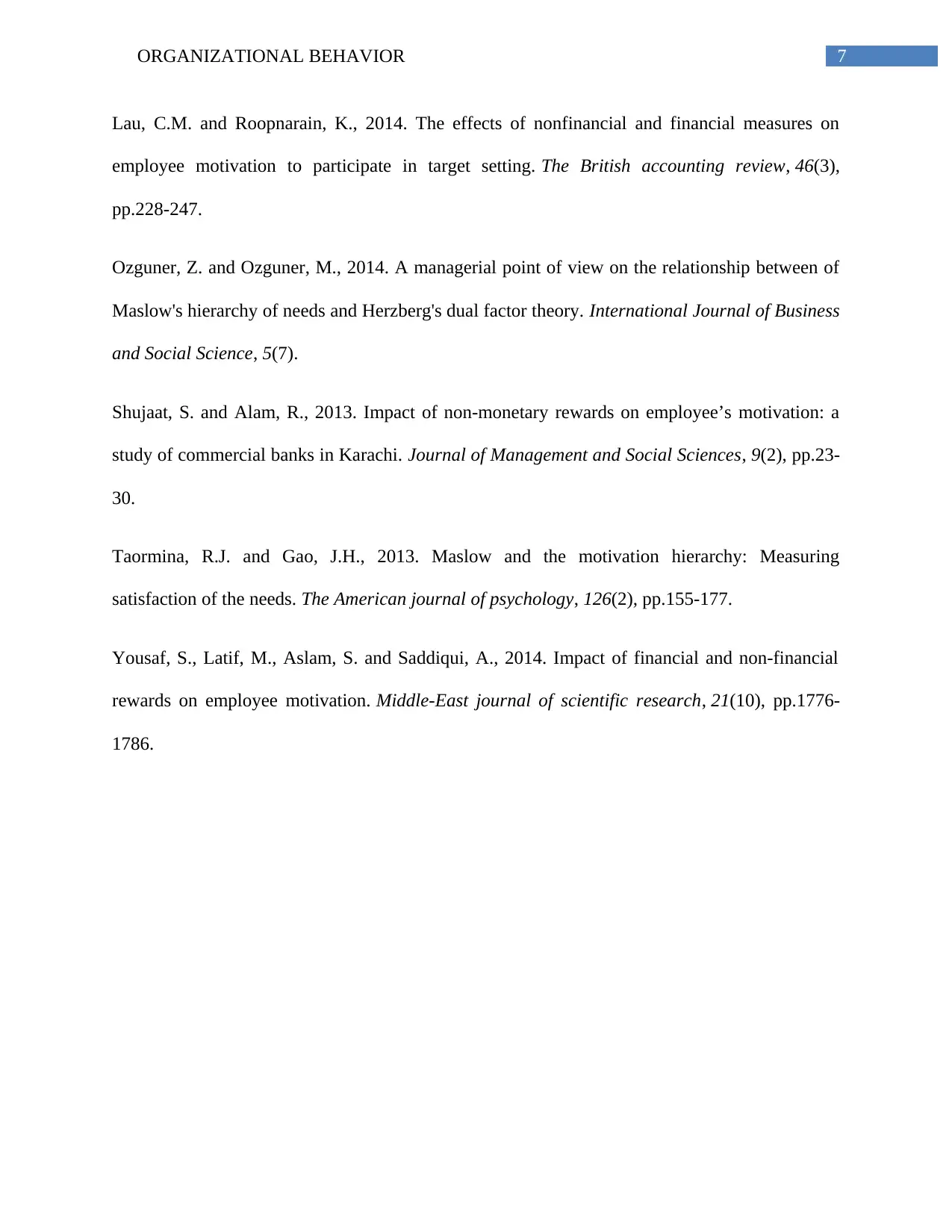
7ORGANIZATIONAL BEHAVIOR
Lau, C.M. and Roopnarain, K., 2014. The effects of nonfinancial and financial measures on
employee motivation to participate in target setting. The British accounting review, 46(3),
pp.228-247.
Ozguner, Z. and Ozguner, M., 2014. A managerial point of view on the relationship between of
Maslow's hierarchy of needs and Herzberg's dual factor theory. International Journal of Business
and Social Science, 5(7).
Shujaat, S. and Alam, R., 2013. Impact of non-monetary rewards on employee’s motivation: a
study of commercial banks in Karachi. Journal of Management and Social Sciences, 9(2), pp.23-
30.
Taormina, R.J. and Gao, J.H., 2013. Maslow and the motivation hierarchy: Measuring
satisfaction of the needs. The American journal of psychology, 126(2), pp.155-177.
Yousaf, S., Latif, M., Aslam, S. and Saddiqui, A., 2014. Impact of financial and non-financial
rewards on employee motivation. Middle-East journal of scientific research, 21(10), pp.1776-
1786.
Lau, C.M. and Roopnarain, K., 2014. The effects of nonfinancial and financial measures on
employee motivation to participate in target setting. The British accounting review, 46(3),
pp.228-247.
Ozguner, Z. and Ozguner, M., 2014. A managerial point of view on the relationship between of
Maslow's hierarchy of needs and Herzberg's dual factor theory. International Journal of Business
and Social Science, 5(7).
Shujaat, S. and Alam, R., 2013. Impact of non-monetary rewards on employee’s motivation: a
study of commercial banks in Karachi. Journal of Management and Social Sciences, 9(2), pp.23-
30.
Taormina, R.J. and Gao, J.H., 2013. Maslow and the motivation hierarchy: Measuring
satisfaction of the needs. The American journal of psychology, 126(2), pp.155-177.
Yousaf, S., Latif, M., Aslam, S. and Saddiqui, A., 2014. Impact of financial and non-financial
rewards on employee motivation. Middle-East journal of scientific research, 21(10), pp.1776-
1786.
1 out of 8
Related Documents
Your All-in-One AI-Powered Toolkit for Academic Success.
+13062052269
info@desklib.com
Available 24*7 on WhatsApp / Email
![[object Object]](/_next/static/media/star-bottom.7253800d.svg)
Unlock your academic potential
Copyright © 2020–2025 A2Z Services. All Rights Reserved. Developed and managed by ZUCOL.





